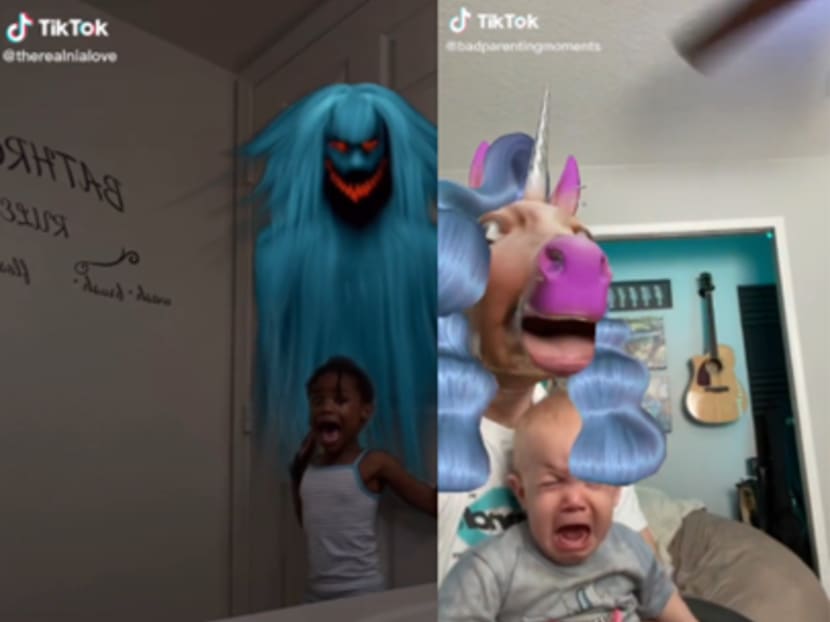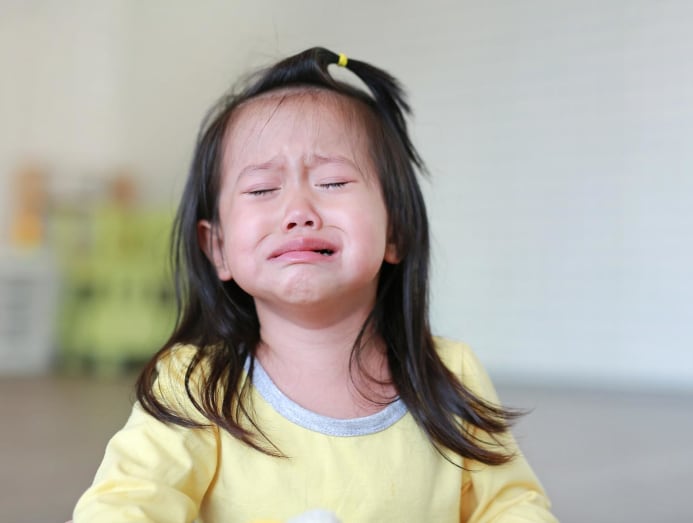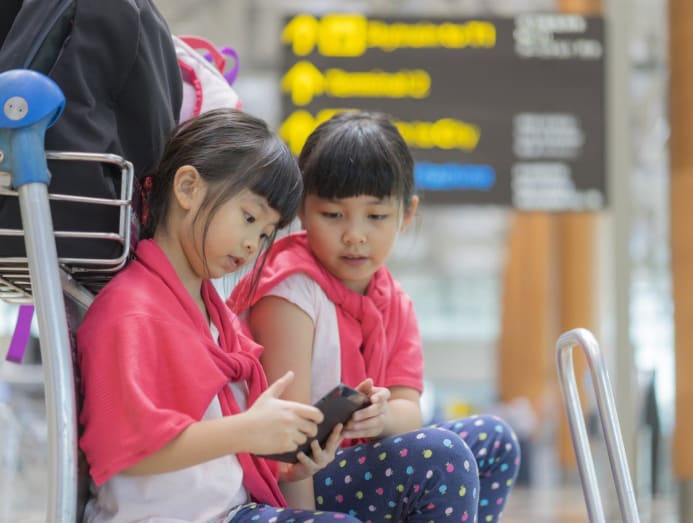Ask a therapist: How does pranking my child on social media affect them in the future?
Have child pranks on TikTok crossed the line? A clinical psychologist weighs in on how they impact children’s wellbeing and relationships with parents.

(Screengrab: TikTok/therealnialove, badparentingmoments)
Everyone loves candid videos of children, and nowhere on social media are unadulterated directions more celebrated than on TikTok. No wonder parents are hopping on the bandwagon of child pranks.
But what happens if a child responds with not joy, but distress? Two camps have emerged from recent discourse. One is concerned for their wellbeing, another believes it’s no cause for concern.
“Sharenting”, a neologism for sharing sensitive content about children on the Internet, is often examined through the lens of ethics and cyber safety, but little has been said about its impact on child psychology.
CNA Lifestyle spoke with Dr Lin Hong-hui, principal clinical psychologist at The Psychology Atelier and a lecturer at Nanyang Technological University, to unpack just that.

SOCIAL MEDIA AND THE PARENT-CHILD BOND
Let’s start with something less contentious. A child blows the seeds off of a dandelion and starts laughing hysterically. It’s the most endearing thing their parents have seen all week, so they whip out their phones and ask them to reenact the moment for social media. What could go wrong?

“When a child does something pure and innocent, they are intuitively expressing their needs for curiosity and exploration. It is lovely for parents to enjoy their cuteness and, in today's norms, express their pride through recording and sharing the moment,” Lin said. She added that things aren’t black and white, and the extent to which they rely on social media for parent-child interactions matters.
“This is more concerning when a parent’s interest and positive feelings are primarily shown through these ways. Unknowingly, they could send a message to their child that: In order to receive attention and affection, I need to ‘perform’.”
This message, when internalised, can communicate the opposite of unconditional love.
“Self-worth is built on love and acceptance of a child as a person – period. A child is good enough, not only when they behave well or show positive moods. If a parent’s positive feelings are tied to these conditions, children may feel that simply being themselves isn’t worthy enough."
THE PSYCHOLOGICAL IMPACT OF PRANKS
You may have heard of TikTok’s controversial ghost filter prank. Children are locked in a room with the app, and a “ghost” appears on the front camera. Some were tickled, but others were seen screaming and struggling to escape. Like them, much of the Internet was not amused. The platform, along with parents who participated, soon came under fire.
Polarising views aside, it is perhaps more useful to ask: What can all parents, even those who film their children’s meltdowns without posting them on social media, take away from this incident? Paying attention to how a child is experiencing being photographed or filmed is a good start.
“If they’re distressed, they need emotional support. When parents take a video instead, they become bystanders to their child's distress, which negatively impacts a child's trust in them. If a child is clearly unhappy, self-conscious, or embarrassed, they need their parents to stop recording and attune to them.”
Attunement, according to Lin, is a parent’s ability to read their child’s emotional state and meet their needs. It builds connection and cultivates a sense of self for the child. When parents, who’re supposed to be safe figures, become the very source of fright, two critical aspects come into question. A child’s sense of self-worth, and their ability to trust.

“These are two fundamentals of the psychological development of a secure self. When parents frequently miss, ignore, or misread their child's needs, it raises doubts in their minds. I don't feel good, but how come Mummy and Daddy can't help me? Can I trust my closest people to take care of me? They don't get me – is it because something's wrong with me?”
When a parent’s attunement is highly unpredictable, a child’s sense of security is shaky. Later in life, this informs their approach to relationships and challenges.
DISTRESS ON DISPLAY
Imagine a child wailing at daycare because he wasn’t picked up on time. It’s a big deal for him, but a small scheduling hiccup for his parents. Intrigued, they capture his “outsized” reaction on camera. This video is later circulated in group chats and posted on social media.
Something critical has happened here. According to Lin, an embarrassing moment may create feelings of shame in private. But, once it’s public, shame turns into humiliation by definition. Parents may look back at these videos fondly but children, upon becoming aware and conscious, may not.
“This impacts a child’s impression of their parents. Why did they post this video? Did they think it was ok? Did they care about me? As children become aware of others’ opinions of them, some may laugh it off but others could experience humiliation. They may also feel hurt and angry that their parents are active participants in sharing their embarrassment,” Lin said.

“Frequent exposure to social media also shapes a child's impression of the world and heightens social comparisons. A child may start basing their self-worth on the perceptions of others through comments and likes. Is their world kind or critical? How should they behave to be ‘worthy’ to this world?”
Of course, children sometimes forget. That’s a valid argument. However, Lin stressed that emotionally significant events can go unreported when children aren’t of the developmental age to do so, only to show up down the line.
“How might these incidents manifest? If I have to do public speaking, I may be crippled by fear because I think I’ll be laughed at. I’m having difficulty, but keep things to myself as I don’t feel I can trust my parents with my vulnerable feelings.”
Such internal pressures and stressors, when snowballed, become risk factors in different aspects of life.
POSTING ON SOCIAL MEDIA MINDFULLY
What’s it like to have your existence documented, starting with an ultrasound scan? Or to receive hundreds of comments on Instagram before you learned to be self-conscious? We never had to contend with this, but this generation of children someday will.
“We don’t really have an answer at this point. Because of the lack of long-term studies, we’re subjected to these unknowns,” Lin conceded. “Even if a child says they’re okay, their consent isn’t informed because they cannot fully appreciate the long-term effects of their decisions. So the responsibility falls on adults and parents to consider the consequences and serve their best interest.”

Asked about ways to better navigate social media, she acknowledged that while most parents are well-meaning, being mindful of their intentions can go a long way.
“It’s very normal to (post on social media) without much thought. So we’re saying, can we pause before hitting the ‘share’ button? Would I be okay if someone took and shared a video of me in this manner? If I’m sharing a cute moment, does it have to be a video of them in distress? If I’m keeping my family updated, does it need to be this video? If it’s for a keepsake, does it need to be public?”
For instance, making an Instagram account private or using the “close friends” function limits their content to a smaller and more trusted audience. If it’s available to the general public, sensitive information such as full names, birthdays, schools, location tags, and even children’s faces can be concealed.
“To err on the side of caution, never share compromising videos or photos that are potentially embarrassing and humiliating. Think of it this way: If a future school, scholarship board, or employer sees these, what kind of impression are they going to form?”
These considerations may seem far-fetched but, ultimately, we can foresee the implications of a child’s digital footprint no more than we foresaw technological leaps in the last decade.








